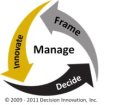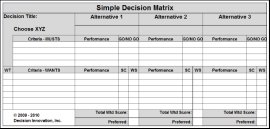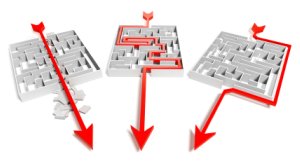How to make a decision - The Decide step
 Addressing how to make a decision is the essence of the Decide step. In this stage of the decision making process, we bring together success factors and decision alternatives for evaluation that will increase clarity for making a sound decision.
Addressing how to make a decision is the essence of the Decide step. In this stage of the decision making process, we bring together success factors and decision alternatives for evaluation that will increase clarity for making a sound decision.
We recognize that the quantitative decision making that is used in our process is most appropriate for decisions of high value that are often very complex. Fortunately, our decision making model enables reuse of knowledge from others that have made the same or similar decisions. As you start to use our decision analysis process, you may find that your thinking on how to make a decision changes, even for decisions that appear less significant.
Upon reaching this point in the decision making process, you should have a prioritized set of success criteria developed during decision framing, and a broad set of decision alternatives (5 to 9) generated from the Innovate step.
How to make a decision - Preparing for decision analysis

Now that you are ready to evaluate the decision alternatives against your success factors, it can be helpful to have a decision making tool to make it easier to complete the Decide step. Prepare for analysis with these steps:
- Transfer the criteria and alternative solutions to your preferred analysis tool - Scoring will require evaluating each solution for each success criteria. This is facilitated by a worksheet, spreadsheet, or decision making software. (Get our decision evaluation worksheet at no cost to help you complete the Decide step.)
- Map any remaining issues or concerns - For important decisions, it is likely that some issues or concerns have been identified during the decision making process. Before evaluating your choices, these issues should be mapped to the appropriate decision elements using our decision making model.
- Collect Information - Using the data gathering plan developed in the Frame step, collect the information that will be used when comparing decision alternatives for each of the criterion that you will be evaluating. Use a single unbiased source for each success factor, if possible. If there is a reliable but biased source, it can be used in a relative comparison to eliminate the bias. If multiple sources are used to provide data for the same criterion, seek to use sources of equal integrity.
- Define the Need (Must) Limit and Desire (Want) Ideal for each criterion across all options - How to make a decision is all about meeting needs/desires. Need limits clarify the minimums/maximums that a solution alternative must satisfy. For options that meet the identified limit, analysis will help identify the solution that best moves toward the desire ideals that you have identified.
How to make a decision - Performing the decision evaluation

Many decision making techniques can be used to perform the decision evaluation. For the Decide step, we support using multiple criteria decision analysis (MCDA) as it can be used for decisions of any value. Because of its essential simplicity, MCDA is easy to apply to choices of all types. Of all the techniques, we have found it to be the easiest to increase or decrease in complexity as needed to match the value of the decision to be made.
- Evaluate options against needs/musts - Even satisficing for a decision requires that your selected solution meet your mandatory or "must" criteria. By analyzing your alternatives with these factors first, you will reduce your analysis effort by eliminating alternatives that will not address fundamental requirements.
- Evaluate alternatives against desires/wants - Compare and assess each option against your highest weighted success factors (desires/wants). Assess one criterion against all the alternatives to avoid bias and better estimate the relative performance (above the need limit) for that criterion for each solution. Start with the highest weighted criteria first so if you run low on time, you will have evaluated your options against the factors most important to success.
 Consider the risks and opportunities for each solution alternative - Excessive risks may cause you to eliminate an option even if it performed well against the success criteria. Similarly, opportunities may cause you to reconsider an otherwise poorly performing solution alternative. This part of decision analysis process ensures that solutions that are overloaded with risk and uncertainty are evaluated fairly against more feasible options.
Consider the risks and opportunities for each solution alternative - Excessive risks may cause you to eliminate an option even if it performed well against the success criteria. Similarly, opportunities may cause you to reconsider an otherwise poorly performing solution alternative. This part of decision analysis process ensures that solutions that are overloaded with risk and uncertainty are evaluated fairly against more feasible options.- Select the best solution alternative - After considering adjustments for both risk and opportunity, select the option that best meets the success criteria.
How to make a decision - Preparing for action
- Summarize overall rationale - Take what you have learned from the decision analysis process and reduce it to a concise summary of the rationale for your final selection. This rationale will enable communication to those that might be impacted by the decision. Nothing helps more with commitment than knowing why an alternative was selected.
- Communicate the decision - When you communicate expect to accomplish two things:
- Get quick feedback, particularly from those close to the decision
- Enlist help and support in decision implementation
A key part of how to make a decision is having an effective decision analysis process that is reliable and repeatable. The quantitative decision making approach used in the Decide step satisfies both. Completing this step in the decision making process positions you to be confident in the decision with the analysis and rationale that can easily be communicated to enroll others.
Performing a decision analysis well takes a high-quality effort, but commitment to a decision is demonstrated through clear directed action aligned with the selected solution. Now it is time to manage the decision implementation and consequences.

Return from How to make a decision to Decision Making Process
